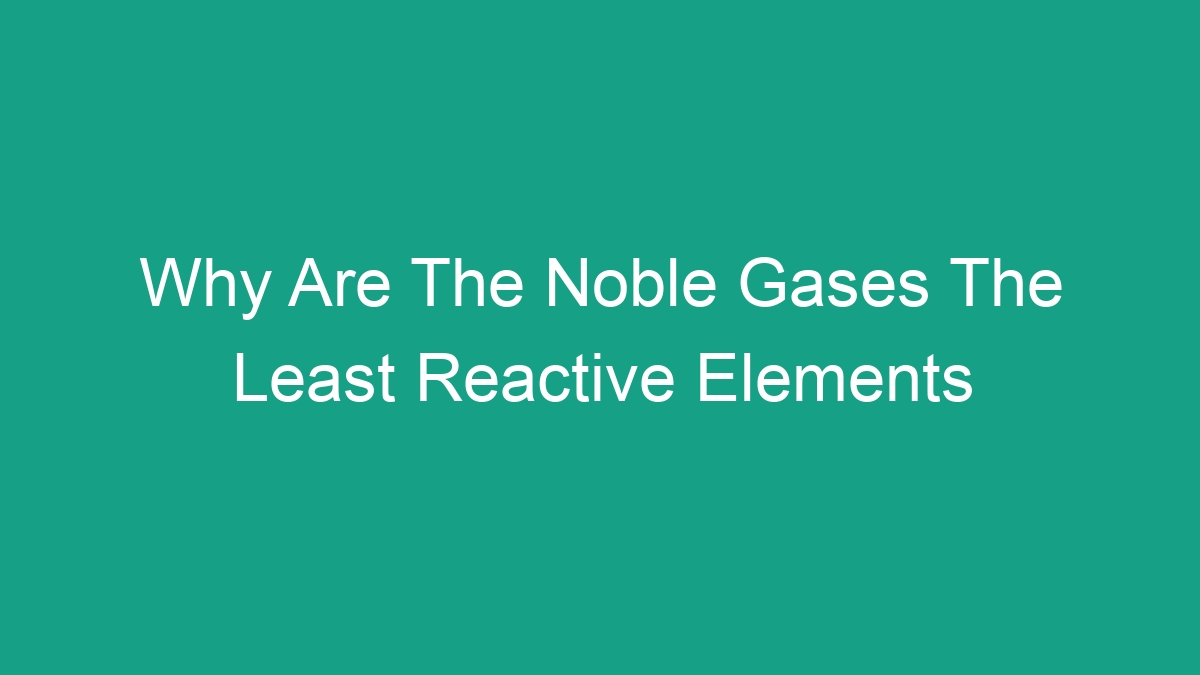
When it comes to the periodic table, the noble gases are often described as the least reactive elements. But what exactly makes them so unreactive compared to other elements? In this article, we will explore the unique properties of noble gases and the reasons behind their low reactivity.
What are Noble Gases?
Noble gases, also known as inert gases, are a group of chemical elements in the periodic table. The noble gases include helium (He), neon (Ne), argon (Ar), krypton (Kr), xenon (Xe), and radon (Rn). These elements are located in Group 18 of the periodic table and are characterized by their complete outer electron shells, which makes them highly stable. This stability gives them their low reactivity, making them the least likely to form chemical bonds with other elements.
Electronic Configuration and Stability
One of the primary reasons for the low reactivity of noble gases is their electronic configuration. Each noble gas possesses a complete outer electron shell, also known as an octet. This means that their outermost energy level is fully occupied with electrons, making them highly stable and unreactive. The stability of their electron configuration is a result of the number of electrons in their outermost shell, which follows a pattern of 2, 8, 18, 32, and so on. This complete outer shell prevents the noble gases from readily gaining or losing electrons to form chemical bonds with other elements.
The electronic configuration of noble gases can be represented as follows:
| Element | Electron Configuration |
|---|---|
| Helium (He) | 1s2 |
| Neon (Ne) | 1s2 2s2 2p6 |
| Argon (Ar) | 1s2 2s2 2p6 3s2 3p6 |
| Krypton (Kr) | 1s2 2s2 2p6 3s2 3p6 4s2 3d10 4p6 |
| Xenon (Xe) | 1s2 2s2 2p6 3s2 3p6 4s2 3d10 4p6 5s2 4d10 5p6 |
| Radon (Rn) | 1s2 2s2 2p6 3s2 3p6 4s2 3d10 4p6 5s2 4d10 5p6 6s2 4f14 5d10 6p6 |
Weak Intermolecular Forces
Another factor contributing to the low reactivity of noble gases is their weak intermolecular forces. In most cases, elements bond with each other through various types of chemical bonds, such as ionic bonds, covalent bonds, or metallic bonds. However, noble gases do not readily form these types of bonds due to their stable electron configuration. Additionally, noble gases have extremely weak intermolecular forces, which are the attractive or repulsive forces that exist between molecules. This further reinforces their lack of reactivity, as the weak intermolecular forces make it difficult for noble gases to interact with other elements to form compounds.
High Ionization Energy
Noble gases also possess high ionization energies, which are the energy required to remove an electron from an atom in the gaseous state. The high ionization energies of noble gases contribute to their low reactivity, as it is energetically unfavorable for them to lose electrons and form positive ions. This is due to the stable electron configuration that noble gases already possess. The high ionization energies make it extremely difficult to remove electrons from noble gas atoms, further reinforcing their reluctance to form chemical bonds with other elements.
Low Electron Affinity
Electron affinity is the energy change that occurs when an atom gains an electron. In the case of noble gases, their low electron affinity further contributes to their low reactivity. Noble gases have little to no tendency to gain electrons, as their electron configurations are already stable with a complete outer shell. This reluctance to gain electrons makes it unlikely for noble gases to form chemical bonds with other elements, as they do not readily participate in the electron transfer process that is essential for bonding.
FAQ
Now that we have explored the reasons behind the low reactivity of noble gases, let’s address some frequently asked questions about these inert elements.
Q: Can noble gases form compounds with other elements?
A: While noble gases are typically unreactive, there are certain conditions under which they can form compounds with other elements. These compounds, known as noble gas compounds, are generally formed under extreme conditions, such as high pressures and temperatures. One example of a noble gas compound is xenon hexafluoroplatinate (XePtF6), which is produced under specific laboratory conditions.
Q: Why are noble gases used in lighting and display applications?
A: Noble gases are often used in lighting and display applications due to their ability to produce colorful and stable luminescence. For example, neon gas is commonly used in neon signs, where an electrical discharge causes the gas to emit a bright red-orange glow. Similarly, argon and krypton are used in gas discharge lamps, such as those found in high-intensity discharge (HID) lighting and some types of fluorescent lights.
Q: Are noble gases harmful to humans?
A: In their pure form, noble gases are non-toxic and generally pose no harm to humans. However, certain compounds of noble gases, such as radon gas, can be hazardous to health. Radon, a radioactive noble gas, is a naturally occurring gas that can accumulate in enclosed spaces, such as homes and buildings, and pose a risk of exposure to radiation. Proper ventilation and testing for radon levels can help mitigate the risks associated with this noble gas compound.
In conclusion, the low reactivity of noble gases can be attributed to their stable electronic configuration, weak intermolecular forces, high ionization energies, and low electron affinity. These unique properties make noble gases the least reactive elements in the periodic table, and they have found various practical applications due to their inert nature.



